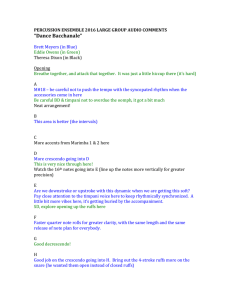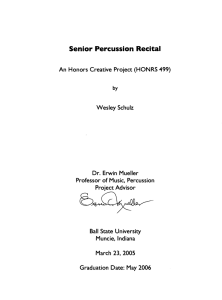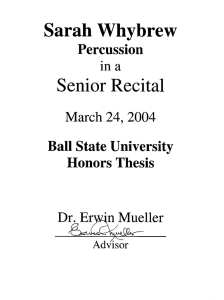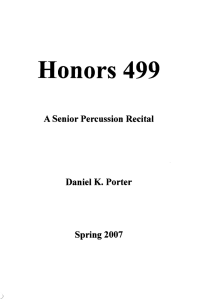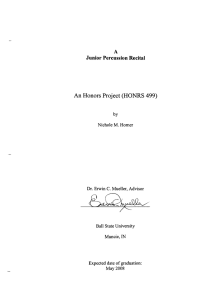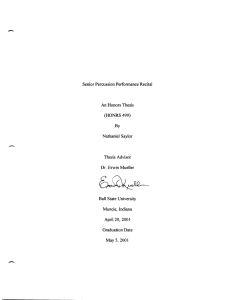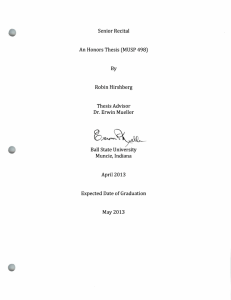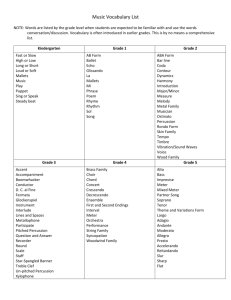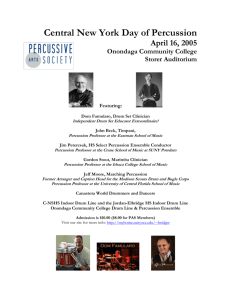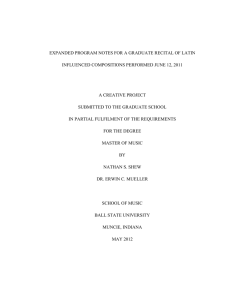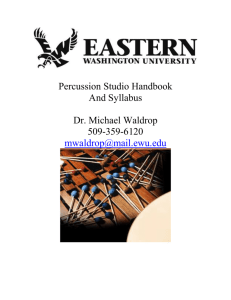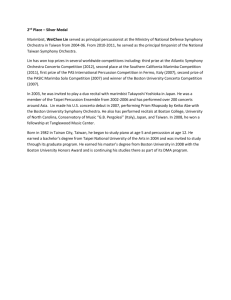- .-..
advertisement
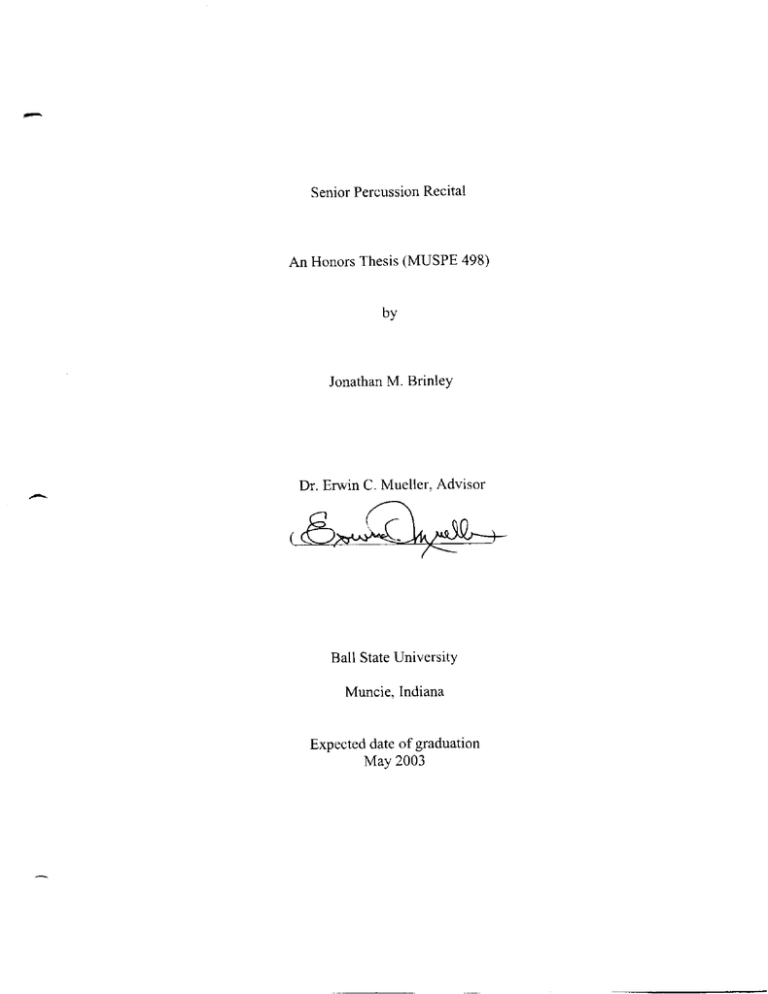
Senior Percussion Recital An Honors Thesis (MUSPE 498) by Jonathan M. Brinley .-.. Dr. Erwin C. Mueller, Advisor Ball State University Muncie, Indiana Expected date of graduation May 2003 - - .--u Abstract '-" This recital marks the culmination of four years of study as a percussion performance major. Its program includes six pieces representative of my studies in performance. The accompanying program notes help the listener to better appreciate and enjoy the music I performed. In the recital, I performed four pieces on the marimba, one on timpani, and one on snare drum. This is representative of my studies, which focused on the marimba, but did include study on the timpani and the snare drum. I opened the recital with the first movement of the Concerto for Marimba and Orchestra, by Anders Koppel. This piece helped to take my four-mallet technique to new levels, requiring much more than any of the other pieces. The next piece, Canaries, by Elliot Carter, demonstrated not only my ability to play the timpani; it also emphasized a significant idea in music theory: metric modulation. Keiko Abe's Michi is representative of the large selection of music for marimba composed by Japanese percussionists. The first two movements of Guy Gauthreaux's American Suite for Unaccompanied Snare Drum demonstrate the two main styles of snare drumming that I have worked with at Ball State, the concert style and the rudimental style. Paul Creston's Concertino for Marimba and Orchestra is one of the major works studied by developing percussionists. Its three movements cover a wide range of styles and require a well-developed technique, both with two-mallet and fourmallet playing. The Three Preludes for Marimba are representative of the works ofNey Rosauro, one of the leading contemporary percussion composers. Acknow Iedgements Dr. Erwin Mueller, my teacher and advisor, for his four years of support and encouragement, without whom none of this would be possible. Barbara MueHer, for her piano accompaniment, without whom half of this would not be possible. Mom and Dad (a.k.a. Bob and Debbie Brinley), who have shown amazing support and encouragement for twenty-one years. I cannot imagine being where I am today without them. - Jonathan Brinley Senior Percussion Recital Program Notes Anders Koppel was born into one the foremost musical families in Denmark. Following the tradition of his father, Herman D. Koppel, Anders composed the Concerto for Marimba in a style that neither completely embraces nor rejects neo-classicism. This very chromatic work never quite crosses the line from tonality into atonality, but it certainly flirts with it. The first movement shares the keys of A major and C minor, with each key having some areas to itself, while in other areas the two keys are both clearly present and fighting with each other. This conflict, combined with a powerful (and almost jazz-like) feel, makes this movement a remarkably challenging and intense piece of music. Canaries is the seventh movement of Elliot Carter's Eight Pieces for Four Timpani. The canary is a Spanish dance originating in the Canary Islands and popular in Europe around the 17th century, and it is from this dance that Carter draws the rhythm that serves as the basis for the movement. The canary has been characterized as a "fiery wooing dance with rapid heel-and-toe stamps and noisy sliding steps."(Grove Music) This piece makes use of Carter's novel compositional technique of metric modulation. Tempo changes occur frequently, but the new tempo is always related to the previous tempo. (In music theory classes, it usually involves complex mathematical equations. In the music, though, the new tempo is prepared by the rhythms immediately preceding it, so one can perform it accurately without using a calculator and a metronome at each tempo change.) Carter also explores the different timbres available on the timpani by calling for some notes to be played near the center of the head, some played normally, and some played near the rim. Keiko Abe has been composing and performing percussion music since the 1950's. The large repertoire of works she has composed earned for her the honor of admission to the Percussive Arts Society Hall of Fame in 1993. Michi, like many of her works, grew out of her improvisatory style, and the beginning and end are still open for improvisation by the performer. Michi is in an arch form; the piece moves through four sections, and then works its way back through the sections, though each section is somewhat abridged in its reprise (ABCDC'B'A'). Senior Chief Musician Guy G. Gauthreaux II is the principal timpanist and percussion section leader with the United States Navy Band in Washington, DC. He composed the American Suite: for Unaccompanied Snare Drum for the Percussive Arts Society Composition Contest in 1989, winning the top prize. This piece showcases various styles of drumming in each of its five movements. The first movement presents a concert style, which is then contrasted by the rudimental style of the second movement. The entire work revolves around a rhythmic motive established at the outset of the first movement, which is modified through various compositional techniques. Paul Creston (originally, Giuseppe Guttoveggio) was born in New York to a poor family of Italian immigrants. He did not decide on a career in composition unt}1 1932, but he attained national recognition within ten years. A focus on rhythm is the hallmark of Creston's style, and this is evident in the Concertino for Marimba. Hemiola (a rhythmic device with which the metrical subdivision of the measure changes) permeates the entire work, giving the feel of a constantly changing meter. Creston's harmonies show a strong influence of Impressionism. Extended dominant quality chords prevent the establishment of a stable tonic, but avoid the dissonance associated with much atonal music. Ney Rosauro began his musical career as a guitarist, making a living playing in Brazilian night clubs and teaching private lessons. At the age of 1977, while studying composition and conducting at the Universidade de Brasilia, he came into contact with percussion instruments and changed the focus of his studies. Rosauro studied and taught at several universities around the world. He currently teaches percussion at the University of Miami. The Three Preludes for Marimba show a wide variety of compositional styles. Rosauro composed the first for guitar in 1976 before adapting it for marimba in 1983, and the guitar-like character of the piece clearly shows through. The second prelude can be characterized as a study in counterpoint. It consists of three contrasting sections before returning to an embellishment of the first section to close the prelude. The third prelude opens with a section of sustained chords that make one question the "C major" portion of the title, but this soon moves on to a more lively section clearly in the stated tonic. The prelude concludes with a restatement of the opening section, closing with a haunting, ambiguous chord. Bibliography Edwards, J. Michele. "Keiko Abe," The New Grove Dictionary of Music Online, ed. L Macy. 24 January 2003 <http://WW.N.grovemusic.com/sharediviews/artic Ie. html ?section=music. 44618>. Hudson, Richard and Meredith Ellis Little. "Canary," The New Grove Dictionary of Music Online, ed. L Macy. 24 January 2003 <http://www.grovemusic.com/sharedlviews/article.html?section=music.04713>. MUCS Guy Gauthreaux. 24 January 2003 <http://www.navyband.navy.mil/guy.htm>. Rosauro, Ney. Ney Rosauro. 24 January 2003 <www.neyrosauro.com>. Schiff, David. "Elliot Carter," The New Grove Dictionary (If Music Online, ed. L Macy. 24 January 2003 <http://www.grovemusic.com/sharedlviews/article.html?section=music.05030>. Simmons, Walter. "Paul Creston," The New Grove DictIOnary ofMusic Online, ed. L. Macy. 24 January 2003 <http://www·hJfOvemusic.com/sharediviews/article.html?section=music.06817>. Werner, Sven Erik. "Herman D. Koppel," The New Grove Dictionary ofMusic Online, ed. L Macy. 24 January 2003 <http://www.grovemusic.com/sharedlviews/article. html?section=music. 15367>.
